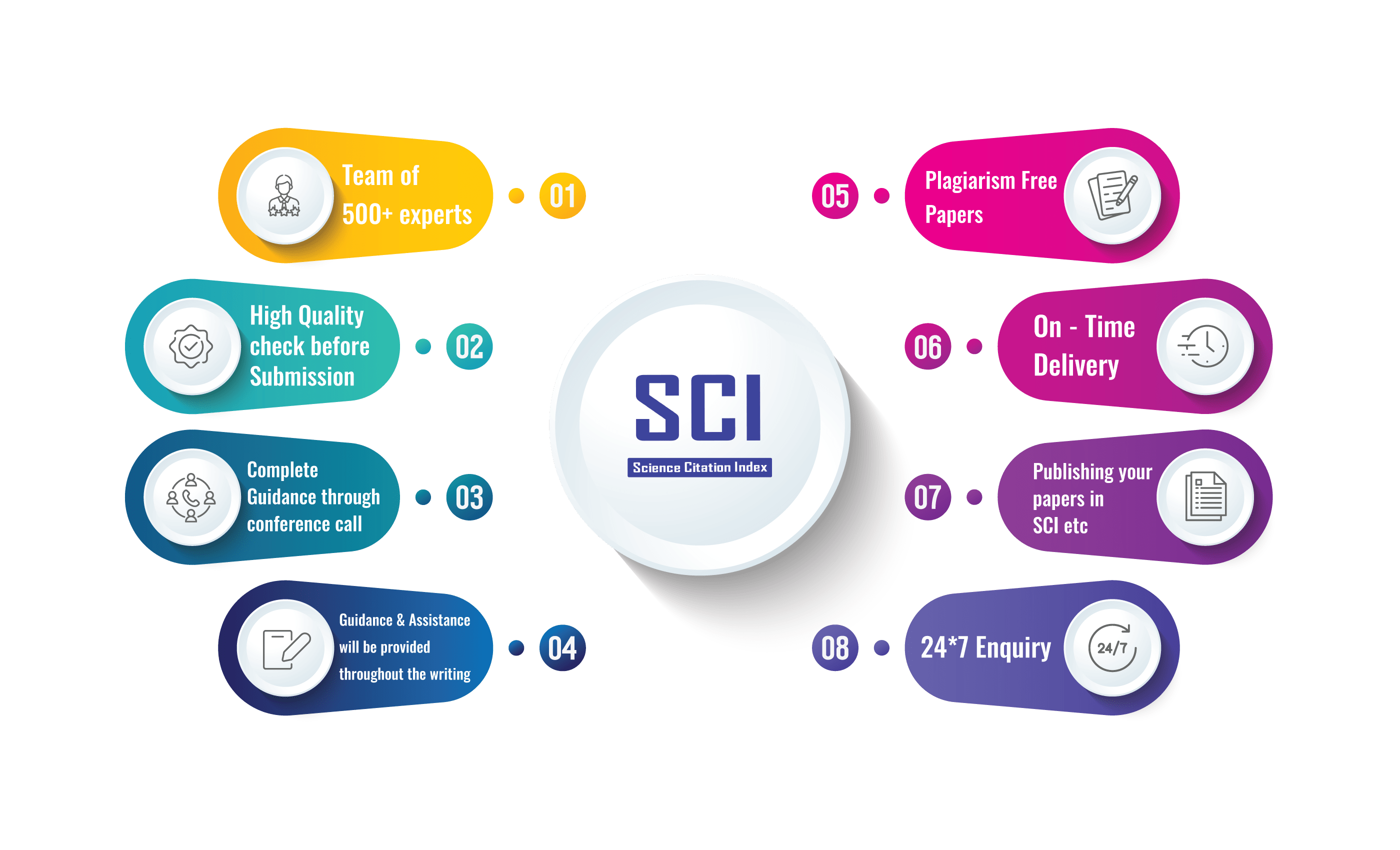Full form of SCI indexed journal is Science Citation Index. It is a prestigious academic publication recognized for highest standard quality journals across various disciplines and maintained by Clarivate. SCI indexed journals ensures high credibility, worldwide visibility and citation tracking. These makes researchers widely recognized in scholarly contribution.


Our Zonduo service has a team of experienced and skilled writers who are experts in providing high-quality PhD research articles for publication in SCI indexed journal. We understand the importance of publishing research in reputable journals and we work closely with our clients to ensure that their study meets the standards of their target journals and assured to write a structured, impactful research article which has high increasing chances of acceptance. With our commitment to excellence and attention to detail, you can trust that your PhD research article will be in good hands with Zonduo. Contact us today to learn more about how we can help you publish the research and make a meaningful contribution to the field.
The Institute for Scientific Information (ISI) originally created the Science Citation Index Expanded (SCIE publication) as a bibliographic database. It is now owned by Thomson Reuters, the company that releases the journal impact factor annually. The Science Citation Index (SCI) is a quarterly publication that features articles and papers in all study fields. SCIE, which is an updated version of sci index journals, is a collection of over 8,500 highly esteemed journals across 150 disciplines.
The full form of sci Science Citation Index (SCI) is a subset of the Science Citation Index Expanded (SCIE publication), which includes journals that rank competitively among the most highly-cited core journals in their respective categories. Previously available only on CD-ROM/Diskette, the Science Citation Index Expanded is now essentially a web-based version of the same database.
All science journals in our database are included in the Science Citation Index Expanded. However, only the journals with significantly higher citation impact are chosen for inclusion in the Sci Indexed journal.
Select the right SCI journal.
You should follow the journal guidelines for formatting, structure, and references.
Your writing should be clear, easily understandable, and precise.
Use high quality visuals like table images or graphs to effectively present your data.
Ensure the manuscript is plagiarism free.
Ensure originality, clarity, and scientific quality.
Proofread the manuscript and ensure it is grammatical and error free.
Summarize your research objective, key results, and conclusion clearly and with understanding.
Once your revisions are accepted, the editor will finalize the decision, and your article will be published and indexed in the SCI database.
To check whether the journal is indexed or not in the Web of Science database.

Writing a PhD research article for publication in SCI (Science Citation Index) is a challenging task that requires a deep understanding of the subject matter, a strong command of the English language, and the ability to write in a clear and concise manner.
In this article, we will explore the key elements of writing a PhD research article for publication in SCI Indexed journal.
The first step in writing a PhD research article for sci publication is to choose a suitable journal that aligns with the scope of research. And the requirements for publication. You should also read the guidelines for authors carefully, paying attention to formatting requirements, word count limits, and specific instructions for submitting the manuscript.
The abstract is the first section of your article that readers will see, so it should be clear and concise, summarizing your study question, methodology, key findings, and implications. It should be no more than 250 words and should provide a clear overview of your research.
The introduction should provide context for the research and clearly state your study question or hypothesis.It should also explain why the research is important. You should review the literature related to your research question and provide a summary of the key findings and gaps in knowledge.
You should describe your research methods in detail, including the study design, sample size,data collection procedures, and statistical analyses.Explain how the methods align with the research question and hypotheses.Discuss any limitations of the methods & how they may affect the interpretation of your results.
You should present the results clearly and concisely, using tables, graphs, or other visual aids to help readers understand your findings. Discuss your results in the context of previous research and provide explanations for unexpected or contradictory results. Also, you should explore the impacts of the results and how they relate to the existing research.
In the discussion and conclusion section of paper, it is important to interpret your findings, discuss their implications, and suggest possible areas for future research. Summarize your key findings and explain how they add to the current understanding of the topic. Additionally, it is important to discuss any limitations of study and how they may impact the interpretation of your results.
Before submitting your manuscript, carefully revise and edit it for clarity, coherence, and accuracy. Check for errors in grammar, spelling, and punctuation, and make sure your citations and references are correct. You should also have someone else read your manuscript to provide feedback and suggestions for improvement.
Once you are satisfied with your manuscript, follow the submission guidelines carefully to ensure that your article is considered for publication. Keep track of the status of your submission, and be prepared to respond to any feedback or requests for revisions from the journal's reviewers. If your manuscript is accepted for publication, be prepared to work with the editors to make any necessary revisions and to respond to any queries from the copy editor or production staff.Manuscript writing is a high focus for Publications
The two key terms of SCI indexing is SCI (Science Citation Index) and SCIE (Science Citation Index Expanded). Both journals are included in Clarivate’s Web of Science database, but there is some differences:
SCI: The core set of journals that are included in the database.
SCIE: This is an expanded version of SCI, includes a wide range of journals, especially focus on interdisciplinary research. SCIE journals trend to have a broader geographical reach and represent a various sets of scientific disciplines.
The SSCI refers to Social Sciences Citation Index alongside its commonly used version SCI. The Science Citation Index handles natural science along with applied sciences.
SSCI exclusively serves social sciences through studies of sociology, psychology and economics and political science.
The purpose of these indexes remains identical since them both track citations to support quality research.
One of the most recognized journals globally is the Science Citation Index (SCI). The SCI indexing system is crucial for academic research for many reasons:
Journal indexed in SCI basically has an impact factor, which evaluates the frequency with which the journal’s articles are cited. This metrics is useful indicator of the journal’s reputation and influence within the scientific community. Researchers aim to publish in journals with a higher impact factor to ensure that their work reaches a larger audience and makes a more important impact.
Journals gets indexed in SCI is a mark of quality. It serves that the journal adheres to rigorous peer review standards and editorial practices. Scholars and institutions always prefer SCI- indexed journals for their high credibility.
SCI indexed journals are widely available through Web of Science database, which enhance the visibility of published research. This greater risk helps research to reach a wider audience and contributing to advancements in science and technology.
Publishing in SCI indexed journals is considered as prestigious. Many academic institution and universities recognize the significance of these journals and articles published in them are often needed for academic promotions and funding opportunities.
One of the key factors of SCI journals is their Impact Factor (IF). The impact factor measures the frequency of an article in a specific journals is cited within a certain periods. Journals with a higher impact factor are considered us more influential in the scientific community. A SCI indexed journal list is available online and can be accessed through the Web of Science platform. Researchers can looking for journals in their fields and check their impact factor. The higher impact factors are more likely the research published in those journals will be cited and have an advancing knowledge in the field.

The official Web of Science platform together with other online resources serves as tools for researchers to access the latest SCI-indexed journal lists. The list contains respected journals from fields across the board which acts as a resource for research paper preparation.
| Field | Journal Name | Publisher | ISSN / eISSN |
|---|---|---|---|
| Mathematics | ADVANCES IN APPLIED MATHEMATICS | ELSEVIER SCIENCE | 0196-8858 / 1090-2074 |
| ADVANCES IN COMPUTATIONAL MATHEMATICS | SPRINGER | 1019-7168 / 1572-9044 | |
| Civil Engineering | INTERNATIONAL JOURNAL OF CIVIL ENGINEERING | SPRINGER | 1735-0522 / 2383-3874 |
| ADVANCES IN STRUCTURAL ENGINEERING | SAGE | 1369-4332 / 2048-4011 | |
| Mechanical Engineering | ARCHIVES OF CIVIL AND MECHANICAL ENGINEERING | SPRINGERNATURE | 1644-9665 / 2083-3318 |
| ENGINEERING FRACTURE MECHANICS | PERGAMON-ELSEVIER SCIENCE | 0013-7944 / 1873-7315 | |
| Electrical Electronic Engineering | ELECTRICAL ENGINEERING | SPRINGER | 0948-7921 / 1432-0487 |
| TRANSACTIONS ON EMERGING TELECOMMUNICATIONS TECHNOLOGIES | WILEY | 2161-3915 |
You have several methods to verify if a publishing journal is listed in the SCI database.
Web of Science Search stands as the best determination method for verifying journal presence within their database. Users should enter the journal name into the search bar to perform their lookup.
The journal publisher commonly displays information about its index inclusion including SCI and SCIE and SSCI on their web page.
The scientific journals included in SCI benefit from notable citation indexes because these indexes measure their impact and relevance among scientific experts.
Here, we have listed some SCI-indexed journals in Computer Science and Engineering. This covers top research fields such as artificial intelligence, computer vision, data science, cloud computing, networks, and theoretical computations. These journals are known for their rigorous review process and are included in the Web of Science Core Collection.
Publisher: SAGE
ISSN / eISSN: 1069-2509 / 1875-8835
Publisher: ELSEVIER
ISSN / eISSN: 1574-0137 / 1876-7745
Publisher: WORLD SCIENTIFIC
ISSN / eISSN: 0129-0541 / 1793-6373
Publisher: TAYLOR & FRANCIS
ISSN / eISSN: 1025-5842 / 1476-8259
Publisher: SPRINGER
ISSN / eISSN: 0885-6125 / 1573-0565
Publisher: SPRINGER
ISSN / eISSN: 1868-8071 / 1868-808X
Publisher: SPRINGER
ISSN / eISSN: 0932-8092 / 1432-1769
Publisher: PERGAMON-ELSEVIER SCIENCE
ISSN / eISSN: 0952-1976 / 1873-6769
Publisher: TAYLOR & FRANCIS
ISSN / eISSN: 0952-813X / 1362-3079
Publisher: SPRINGER
ISSN / eISSN: 0924-669X / 1573-7497
The impact factor shows the average number of citations received by articles published in a journal. You can focus on using resources like JCR integrated with Web of Science, to find journals impact factor.
Go to the Web of Science platform. Click the top bar dropdown menu list and select the journal citations report. You can search by journal title, subject, ISSN, and browse categories. Every subject category in a journal can be ranked according to its impact factor.
After you find the journal, check the journal profile and ranking. The profile page displays the journal's impact factor, ranking, metrics, and journal quartile.
| Key difference | SCI | SSCI |
|---|---|---|
| Stands for | Science Citation Indexed | Social Science Citation Index |
| Discipline | Physics, Chemistry, Biology, Engineering, Computer Science, Medical Science, Hard Science | Psychology, Sociology, Education, Political Science, and Economics. |
| Journal coverage | Science and technology | Relevant to social science |
| Citation pattern | Higher citation | Slower citation |
| Publication frequently | More frequently (weekly or biweekly) | Less frequently (monthly or quarterly) |
The full form of SCI, Science Citation Index (SCI), is a subset of the Science Citation Index Expanded (SCIE publication), which includes journals that rank competitively among the most highly-cited core journals in their respective categories. Previously available only on CD-ROM/Diskette, the Science Citation Index Expanded is now essentially a web-based version of the same database. All science journals in our database are included in the Science Citation Index Expanded. However, only the journals with significantly higher citation impact are chosen for inclusion in the SCI-Indexed journals.
| SCI (Science Citation Index) | SCIE (Science Citation Index Expanded) | |
|---|---|---|
| purpose | Selective citation index focuses on high impact journals | More comprehensive index than SCI |
| Journal coverage | 3,500 journal | 9,200 journal |
| selectivity | High selective | Moderate selective |

The academic world depends significantly upon SCI indexing for publishing needs. The indexing process allows prestigious databases to include only peer-reviewed high-quality journals that provide authors with visibility and credibility for their academic work. The academic publishing expert Zonduo helps researchers while providing assistance throughout their manuscript development along with identifying proper publication journals for their discipline. Academic writers need to understand the essential nature of SCI indexing because it helps researchers identify appropriate journals to submit to and improve their academic reputation. An academic writer will benefit from selecting SCI-indexed journals when starting their publishing journey because these platforms produce maximum visibility along with better professional opportunities and improved citation rates. Zonduo recognizes the importance of journal reputation for scholarly publishing so we provide expert services that assist researchers to find suitable SCI, SCIE or SSCI journals for their work.
WHAT ARE THE CHALLENGES FACING IN PUBLICATION PROCESS OF SCI JOURNALS 2025
There are many challenges that researchers face in publishing paper in Science Citation Index (SCI) Journal 2025. Some of the reasons are:
Our team of experts understand your desire to get publish your paper in reputable journals. Our experienced writer have success records of paper publication in SCI journals also. Many researchers are confused about writing paper up to journals standards. Our professional writer helps you in writing perfect paper that easily got shortlisted in top publication.

Our experienced writers offer you a comprehensive services like manuscript editing, formatting, plagiarism checking, journal selection guidance, submission assistance. Our main goal is to enhance the quality and presentation of your research paper, and ensures that the paper meets the expectations of SCI journal to improve the high chances to get acceptance in SCI-indexed journals. We can assist you in writing a strong abstract, improving the quality, checking for any ethical issues and also provide tips for making your research look more impactful.Your satisfaction academic success are important to us. Our experts guide you in entire process.
Ever researcher wishes to publish their paper work in such reputable SCI- indexed journals because
-- It offer scholars global credibility
-- Provides high chances of research reorganization
-- Essentials for their academic reputation, promotions etc
-- Also helps the researchers to gain a competitive edges in their career path
Common Problems Faced by PhD Scholars during Journal Publications
Scholars nowadays are facing many problems in publication process. Here we list some of the common problems faced by PhD scholars in publication process. To know more about it

Yes! We offer SCI journal publication support including journals selection, research manuscript editing, and formatting, and submission and revision guidance.
SCI journal publication fee varies depends on the journal and publisher. We help you to navigate these costs and find option within your budget.
No! SCI is a part of Web of Science, a wide database that includes SCI, SSCI and other citation indexes.
Absolutely! We are specializing in helping researchers prepare and submit their research paper to SCI journals effectively.
An SCI journal requires high-quality research, originality with strong citations and clear methodology. We provide journal selection research manuscripts evaluation services to ensures suitability.
An SCI journal is a peer-reviewed publication indexed in the Science Citation Index or Science Citation Index Expanded, recognized for high academic quality and impact in scientific fields.
Our Zonduo publication service assists with manuscript preparation, journal selection, formatting, submission processes, and addressing reviewer comments to increase acceptance chances.
The process varies but typically takes 10–12 months, including peer review, revisions, and final acceptance, depending on the journal and field.
A publication service can help match your manuscript to journals based on scope, impact factor, audience, and publication speed, ensuring alignment with your research goals.